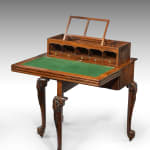Chinese Export Carved Huang Huali Harlequin Table
30 ½ x 30 x 15 ¾ in
Further images
Provenance
with Martin Beazor Antiques 1992
with Jeremy Ltd., London
Private Collection, London
Sold Christie's, London, 23rd April 1998, lot 223
Private Collection USA
Literature
Lucy Wood, The Upholstered Furniture in the Lady Lever Art Gallery, Volume I, Yale University Press, New Haven and London; 2008, illustrated p. 437 figs. 325 and 326A Chinese export huang huali harlequin table, with a rounded rectangular triple-hinged top enclosing a plain surface, a green baize-lined playing-surface with dished counter and candle wells, and a writing-surface with spring-fitted rising section, revealing five pigeon-holes above five small drawers and a book rest, on gateleg cabriole legs headed by lion masks, terminating in paw-and-ball feet on castors.
Such multi-purpose tables were known as ‘harlequin’ after the character known in the 18th century Commedia dell’Arte for being the master of disguises.
A design for a harlequin table of this form is pictured on the trade card of Thomas Potter (d.1782), cabinetmaker of High Holborn. The mechanism is similar to tables shown in engraved illustrations of furniture published in London in the 1730s and signed Potter.
An English table of this model can be found at Temple Newsam House, Leeds. That table is illustrated in G. Gilbert, Furniture at Temple Newsam House and Lotherton Hall, vol. III, Leeds, 1998, pp.658-660.
By 1750, the design was listed as one of the pieces which could be submitted for entry into the trade guild of Wrights and Coopers in Aberdeen.
This table is very similar to an example at Petworth House and Park, West Sussex (National Trust Collections NT 485434).
Another of similar design is in the collection at Harvard Art Museums (Object Number 1943.1579) and a table of comparable form, with less ornate carving to the legs was sold at Sotheby’s 5th June 2007.
The date period of the first examples of these tables being brought to Europe can be established to within a few years from old bills and inventories. Tove Clemmensen writes in Furniture History of a similar table which was brought by Captain Zacharias Allewelt on the ship Kongen af Denmark (The King of Denmark) which sailed on 23 January 1736 and returned to Copenhagen on 20 August 1737. Described as ‘A Chinese table which can be arranged in three ways, made in rosewood, and a good and ingenious piece of workmanship, 80 rix-dollars,’ Allewelt sold the table to King Christian VI and his signature is on the bill. Clemmensen describes the mechanics of the table: ‘A button underneath releases one of the legs which can be swung out and support a table leaf. By rotating a wooden block above the table leg, its height can be regulated according to the number of leaves in use. The table can be converted into either a square table with a smooth top, or a card table with blue velvet and four circular spaces for candlesticks and four oval depressions for counters, or a writing desk with the same velvet surface. Behind the desk flap there is a sloping book rest. This is attached to a “harlequin fitting” consisting of a cabinet of drawers and pigeon-holes, hidden in the body of the table. The cabinet pops up at the touch of a spring.’ (‘Some Furniture Made in China in the English Style Exported from Canton to Denmark 1735, 1737 and 1738’, Furniture History, 1985 p. 175-176). The table was first recorded at Frederiksborg Castle 1860-61 and then moved to Fredensborg Castle where it remains today.














